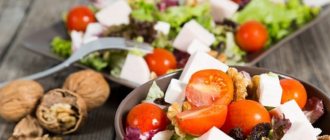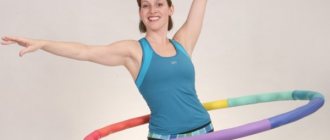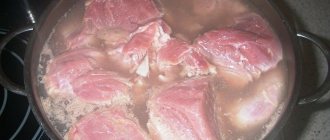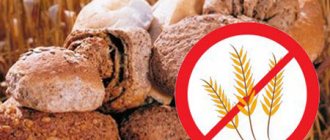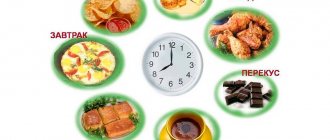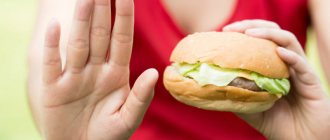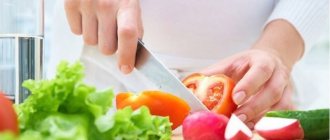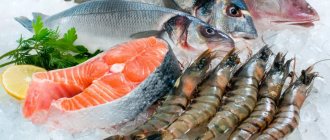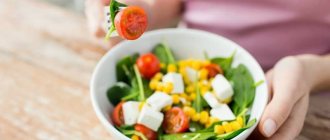General rules
Food intolerance is a pressing medical problem. A special place is occupied by true food intolerance - gluten enteropathy or celiac disease . This disease is characterized by damage to the small intestinal mucosa by gluten (a protein found in products made from wheat, oats, rye or barley) and the appearance of mucosal atrophy.
With celiac disease, the intestinal villi are reduced and atrophied. Degeneration of intestinal villi is the main danger of this disease. Currently, immunological and genetic theories of the occurrence of celiac enteropathy are adhered to. First of all, it is an autoimmune disease.
The intake of gluten maintains a constant inflammatory response in the intestines, and immune cells form antibodies . immunoglobulins is significantly increased , in particular, antibodies to gliadin (a component of gluten) Ig A and Ig G. A high titer of these antibodies is a specific sign of the disease and their detection in the blood makes it possible to establish a diagnosis. There is evidence indicating a genetic predisposition to this disease.
Gluten enteropathy is accompanied by digestive disorders and impaired absorption of all nutrients. It occurs with persistent diarrhea , weight loss, constant bloating, general weakness and decreased performance. In addition, under conditions of a pronounced atrophic process, increased permeability of the mucous membrane develops, and this creates conditions for the occurrence of concomitant food allergies. In patients, an increase in the level of antibodies to soy, milk, and egg proteins is detected.
Late diagnosis increases the risk of complications: osteoporosis , infertility , cancer and neurological disorders. With strict, constant adherence to the diet, the prognosis is favorable.
The main treatment for this disease is a lifelong agliadine diet , which must be followed strictly. Diet therapy is the key to maintaining health. Celiac disease does not disappear with age, since morphological changes in the mucosa persist. If the diet is not followed, the risk of gastrointestinal tumors increases significantly in patients. With impeccable compliance, it is possible to restore the function of the villi within 4-6 months.
The diet for celiac disease in adults involves the complete exclusion of products from wheat, rye, barley, millet, and oats. These include bread, pasta and flour products, all types of wheat cereals (semolina, wheat, bulgur, couscous). It is prohibited to prepare sauces with flour, add even a small amount of bread to the minced meat, and use a breading of breadcrumbs during cooking. It is necessary to exclude cakes, pastries, any pastries made from wheat flour, puddings, cookies, ice cream (may contain flour), dough products and pasta.
The diet uses rice, corn, starch, buckwheat, millet, vegetables and fruits, meat and fish, eggs. To expand the menu, wheat flour substitutes are used: corn or rice, and sauces are made based on potato or corn starch.
When creating a menu, you need to take into account the principles of chemical and mechanical sparing. All products are boiled or steamed. For greater preservation, all dishes are prepared pureed. The principle of fractional meals is also taken into account - 6 times, in small portions. Also excluded are products that cause fermentation and increase the secretion of the pancreas and stomach (broths, spicy dishes, spices, seasonings).
All kinds of meat, chicken, fish, eggs are allowed
With this disease in adults, it is difficult to achieve remission in a short time - it may take up to 5-6 months. However, even then dietary restrictions must be followed, since consuming even 100 mg (a few bread crumbs) can again worsen the patient’s condition.
In this regard, you need to know products with “hidden gluten”, which may not indicate its presence, and also exclude them from your diet. It is these foods that pose the greatest danger if a strict elimination diet is necessary.
These products are:
- canned meat and fish tomato;
- semi-finished soups;
- beer, vodka, whiskey, kvass;
- sausages and sausages;
- instant coffee drinks;
- sauces, ketchups, mayonnaise;
- yoghurts, kefir, glazed cheese curds;
- instant coffee, cocoa powder;
- candies, chocolate;
- coated tablets, syrups with malt.
A relapse of the disease can be caused by eating even a small piece of sausage, semi-finished minced meat or industrial canned food.
In the acute period, in addition to the main diet, it is recommended to eat a diet that excludes milk sugar (milk and dairy products) and common allergens (chocolate, citrus fruits, eggs, fish, strawberries, etc.). More protein is introduced into the diet (140-160 g/day) through meat, poultry, cheese, cottage cheese, and legumes (subject to good tolerance).
The amount of fat increases to 100 g per day. At the same time, you need to limit carbohydrates (no more than 200 g), and temporarily exclude fruits and vegetables. When remission occurs (formed stool), the amount of carbohydrates is increased to 400 g, and the energy value will increase accordingly.
Patients are recommended to use specialized products. In Russia, certified products of foreign production ( Doctor Sher , Galletas Gullon , Semix ) and domestic ( BioFoodLab , Zdorovey , Dietika , D&D , KhlebProm , Shugaroff , Garnets , McMaster ) are presented. These are bread, pasta, rice noodles, waffles, cookies, various types of flour (corn, pumpkin, rice, lentil, amaranth, nut, soy, almond).
What is a diet for celiac disease?
Anyone diagnosed with celiac disease must follow a special diet.
You should avoid gluten, a protein found naturally in several grains, including wheat, barley, and rye (2).
When a person with celiac disease eats gluten, it triggers an autoimmune response in their body that damages the lining of the small intestine.
As a result, the small intestine cannot properly absorb nutrients from food, creating symptoms such as diarrhea and unexplained weight loss, and leading to nutritional deficiencies (3).
The only way to prevent this damage is to strictly adhere to a gluten-free diet.
The celiac disease diet eliminates gluten-containing foods to prevent autoimmune damage to the intestines in people with celiac disease.
Authorized Products
To feed patients, Diet No. 4A/G , which includes:
- Corn, rice, buckwheat, millet, oatmeal. Oats do not contain gluten , but can cause enterocolitis due to the content of the protein avenin , which has similar properties, so the attitude towards oatmeal is twofold. If health conditions deteriorate, it is excluded from the diet. Porridges are prepared in water with the addition of milk and pureed. You can use these same grains to make casseroles or steam puddings. You can also use corn and potato starch when preparing any dishes.
- Bread made from approved types of flour (corn, rice, soy, amaranth, pumpkin) or special gluten-free bread. You can use flour to make any pastries, pancakes, pancakes, cookies and bread.
- Lean meat and fish of all varieties, chicken, turkey, eggs, canned fish (in oil and own juice). Excluded in tomatoes, since flour is used as a thickener. When preparing cutlets, rice or corn flour is used. Meat and fish dishes are consumed at any stage of the disease.
- All vegetables without restrictions in any form (boiled and baked are better tolerated) and legumes (with normal tolerance). Vegetable purees can be prepared from potatoes, zucchini, pumpkin, carrots, and cauliflower. During the period of exacerbation of enteritis, cabbage, onions, beans, green onions, parsley, and dill are limited or excluded.
- Also limited during this period are pickled, pickled and canned vegetables (peas, beans, corn).
- Soups with weak meat and fish broth, vegetable broth with meatballs, egg flakes. Add permitted cereals and finely chopped vegetables.
- Fresh and cooked fruits (jelly, jellies, mousses, compotes), baked pears, apples, quince. The diet includes jam, marmalade, jams, marmalade and homemade marshmallows. With exacerbation of enteritis, limit the consumption of fresh fruits and juices (fruit and vegetable). Dried fruits and compote mixture can be consumed at any stage of the disease.
- Vegetable oil, homemade butter.
- Eggs (omelet, soft-boiled) can be consumed at any stage of the disease.
- Sour cream 15 g in dishes, cream up to 50 g also in dishes. When consuming these products, you need to make sure that they do not contain flour-based thickeners.
- Non-acidic cottage cheese, products made from cottage cheese (steam puddings, casseroles with cereals and vegetables). Cheeses made at home. Fermented milk products are also allowed only at home. If tolerated well, you can drink kefir, yogurt and yogurt. Milk and cream - only in dishes, for example with tea in small quantities (50 g per glass). Non-acidic sour cream (15 g per dish). It should be taken into account that with concomitant lactase deficiency, which occurs in 75% of patients, dairy products are limited or excluded.
- Sugar, honey, natural tea without additives, coffee from whole coffee beans, rosehip infusion, diluted fruit, vegetable and berry juices.
- Homemade canned fish and meat.
- Specialized products: dry protein mixture.
- Industrial canned food (seaweed, peas, corn).
Table of permitted products
| Proteins, g | Fats, g | Carbohydrates, g | Calories, kcal | |
Vegetables and greens | ||||
| vegetables legumes | 9,1 | 1,6 | 27,0 | 168 |
| cabbage | 1,8 | 0,1 | 4,7 | 27 |
| Brussels sprouts | 4,8 | 0,0 | 8,0 | 43 |
| cauliflower | 2,5 | 0,3 | 5,4 | 30 |
| potato | 2,0 | 0,4 | 18,1 | 80 |
| cucumbers | 0,8 | 0,1 | 2,8 | 15 |
| soybeans | 34,9 | 17,3 | 17,3 | 381 |
Fruits | ||||
| apricots | 0,9 | 0,1 | 10,8 | 41 |
| oranges | 0,9 | 0,2 | 8,1 | 36 |
| pears | 0,4 | 0,3 | 10,9 | 42 |
| tangerines | 0,8 | 0,2 | 7,5 | 33 |
| nectarine | 0,9 | 0,2 | 11,8 | 48 |
| peaches | 0,9 | 0,1 | 11,3 | 46 |
| apples | 0,4 | 0,4 | 9,8 | 47 |
Berries | ||||
| grape | 0,6 | 0,2 | 16,8 | 65 |
Nuts and dried fruits | ||||
| nuts | 15,0 | 40,0 | 20,0 | 500 |
| dried fruits | 2,3 | 0,6 | 68,2 | 286 |
Cereals and porridges | ||||
| buckwheat (kernel) | 12,6 | 3,3 | 62,1 | 313 |
| corn grits | 8,3 | 1,2 | 75,0 | 337 |
| millet cereal | 11,5 | 3,3 | 69,3 | 348 |
| white rice | 6,7 | 0,7 | 78,9 | 344 |
| brown rice | 7,4 | 1,8 | 72,9 | 337 |
| brown rice | 6,3 | 4,4 | 65,1 | 331 |
Flour and pasta | ||||
| amaranth flour | 8,9 | 1,7 | 61,7 | 298 |
| dietary corn flour | 7,2 | 1,5 | 70,2 | 330 |
| nut flour | 50,1 | 1,8 | 35,5 | 333 |
| dietary rice flour | 7,4 | 0,6 | 82,0 | 371 |
| pumpkin flour | 33,0 | 9,0 | 23,0 | 305 |
| lentil flour | 28,0 | 1,0 | 56,0 | 321 |
Raw materials and seasonings | ||||
| potato starch | 0,1 | 0,0 | 79,6 | 300 |
| corn starch | 1,0 | 0,6 | 85,2 | 329 |
Dairy | ||||
| milk | 3,2 | 3,6 | 4,8 | 64 |
| kefir | 3,4 | 2,0 | 4,7 | 51 |
| curdled milk | 2,9 | 2,5 | 4,1 | 53 |
| acidophilus | 2,8 | 3,2 | 3,8 | 57 |
Cheeses and cottage cheese | ||||
| cottage cheese | 17,2 | 5,0 | 1,8 | 121 |
Meat products | ||||
| boiled beef | 25,8 | 16,8 | 0,0 | 254 |
| boiled veal | 30,7 | 0,9 | 0,0 | 131 |
| rabbit | 21,0 | 8,0 | 0,0 | 156 |
Bird | ||||
| boiled chicken | 25,2 | 7,4 | 0,0 | 170 |
| turkey | 19,2 | 0,7 | 0,0 | 84 |
Oils and fats | ||||
| vegetable oil | 0,0 | 99,0 | 0,0 | 899 |
| butter | 0,5 | 82,5 | 0,8 | 748 |
Non-alcoholic drinks | ||||
| mineral water | 0,0 | 0,0 | 0,0 | — |
| dry roasted coffee beans | 13,9 | 14,4 | 15,6 | 223 |
| green tea | 0,0 | 0,0 | 0,0 | — |
| black tea | 20,0 | 5,1 | 6,9 | 152 |
Juices and compotes | ||||
| juice | 0,3 | 0,1 | 9,2 | 40 |
| * data is per 100 g of product | ||||
Fully or partially limited products
- Wheat (bulgur, couscous, kamut, semolina and wheat cereals, triticale, spelt, wheat flour, spelled), rye (rye bread and pastries), barley (barley and pearl barley), oats (oatmeal and flour) . These types of flour should not be included in food or breading.
- Dairy and fermented milk products with flour and decoctions (oat and wheat).
- Industrial canned food with the addition of flour, ham, sausages, sausages.
- Semi-finished products (cheesecakes, cutlets, meatballs, nuggets, fish, zrazy), breaded in breadcrumbs. Everything can be cooked at home using approved flour.
- Any confectionery products made from unauthorized types of flour and with the addition of barley.
- Canned vegetables with added flour and cereals.
- Caramel, chocolate, dragees, candies.
- Barley products - talkan flour, drinks, milk.
- Corn flakes that contain the addition of wheat flour.
- Kvass, carbonated drinks, and alcoholic drinks - vodka, beer and whiskey.
The following products may contain unauthorized flours or malt:
- Yogurt, packaged cottage cheese, ice cream, curd mass, condensed milk, dry cream and milk, bread, corn sticks, chips.
- Cheeses, mayonnaise.
- Tomato paste and ketchups.
- Instant coffee, drinks (Pepsi, cola), cocoa powder, granulated tea.
- Marshmallows, halva, Turkish delight, industrially made jam, marmalade and marshmallows.
- You should avoid frozen semi-finished products. If the finished product contains dextrin , modified starch, seasonings, flavorings or vegetable protein, then there is a high probability of gluten content.
- Homemade tomato paste and rosehip decoctions are limited during an exacerbation.
Table of prohibited products
| Proteins, g | Fats, g | Carbohydrates, g | Calories, kcal | |
Vegetables and greens | ||||
| horseradish | 3,2 | 0,4 | 10,5 | 56 |
| sorrel | 1,5 | 0,3 | 2,9 | 19 |
Mushrooms | ||||
| mushrooms | 3,5 | 2,0 | 2,5 | 30 |
Cereals and porridges | ||||
| semolina | 10,3 | 1,0 | 73,3 | 328 |
| oat groats | 12,3 | 6,1 | 59,5 | 342 |
| cereals | 11,9 | 7,2 | 69,3 | 366 |
| pearl barley | 9,3 | 1,1 | 73,7 | 320 |
| Wheat groats | 11,5 | 1,3 | 62,0 | 316 |
| barley grits | 10,4 | 1,3 | 66,3 | 324 |
Flour and pasta | ||||
| pasta | 10,4 | 1,1 | 69,7 | 337 |
Bakery products | ||||
| white bread crackers | 11,2 | 1,4 | 72,2 | 331 |
| vysivkovy bread | 9,0 | 2,2 | 36,0 | 217 |
| Old Russian grain bread | 9,6 | 2,7 | 47,1 | 252 |
| Rye bread | 6,6 | 1,2 | 34,2 | 165 |
| malt bread | 7,5 | 0,7 | 50,6 | 236 |
Confectionery | ||||
| candies | 4,3 | 19,8 | 67,5 | 453 |
| cookie | 7,5 | 11,8 | 74,9 | 417 |
| cake | 3,8 | 22,6 | 47,0 | 397 |
| crackers with raisins | 8,4 | 4,9 | 78,5 | 395 |
| crackers with sugar | 9,5 | 4,2 | 72,1 | 368 |
| dough | 7,9 | 1,4 | 50,6 | 234 |
Ice cream | ||||
| ice cream | 3,7 | 6,9 | 22,1 | 189 |
Cakes | ||||
| cake | 4,4 | 23,4 | 45,2 | 407 |
Raw materials and seasonings | ||||
| seasonings | 7,0 | 1,9 | 26,0 | 149 |
| mustard | 5,7 | 6,4 | 22,0 | 162 |
| ketchup | 1,8 | 1,0 | 22,2 | 93 |
| mayonnaise | 2,4 | 67,0 | 3,9 | 627 |
| rye malt | 9,8 | 1,2 | 66,4 | 316 |
| tomato paste | 5,6 | 1,5 | 16,7 | 92 |
Meat products | ||||
| ham | 22,6 | 20,9 | 0,0 | 279 |
Sausages | ||||
| boiled sausage | 13,7 | 22,8 | 0,0 | 260 |
| dry-cured sausage | 24,1 | 38,3 | 1,0 | 455 |
| sausages | 10,1 | 31,6 | 1,9 | 332 |
| sausages | 12,3 | 25,3 | 0,0 | 277 |
Fish and seafood | ||||
| smoked fish | 26,8 | 9,9 | 0,0 | 196 |
Oils and fats | ||||
| animal fat | 0,0 | 99,7 | 0,0 | 897 |
| cooking fat | 0,0 | 99,7 | 0,0 | 897 |
Alcoholic drinks | ||||
| vodka | 0,0 | 0,0 | 0,1 | 235 |
| beer | 0,3 | 0,0 | 4,6 | 42 |
Non-alcoholic drinks | ||||
| bread kvass | 0,2 | 0,0 | 5,2 | 27 |
| cola | 0,0 | 0,0 | 10,4 | 42 |
| Pepsi | 0,0 | 0,0 | 8,7 | 38 |
| sprite | 0,1 | 0,0 | 7,0 | 29 |
| * data is per 100 g of product | ||||
Diet options
Which foods to focus on depends on whether a person has weight problems.
If you are overweight, you should control your calories and eat less.
Proteins should be up to 110 g, fats - 100 g, carbohydrates - 350, calories - up to 2540, salt no more than 4 g, and water at least two liters per day.
For patients who are not overweight, it is recommended that they consume 120 g of protein, 110 g of fat, 400 g of carbohydrates, 2900 calories, up to 6 g of salt, and at least two liters of liquid.
Menu (Power Mode)
For patients, the best option is to cook at home using fresh ingredients. At the beginning of the diet, it is recommended to exclude dairy products due to possible intolerance to milk sugar. When stool normalizes and bloating disappears, you can try introducing them gradually.
If it is not possible to buy gluten-free bread all the time, you can replace it with homemade bread made from sorghum, corn, buckwheat, flax, and rice flour.
Pancakes, pancakes, and various savory pastries are made from these types of flour, and almond flour is most often used for confectionery baking. Be sure to include fruits and vegetables daily (can be raw or processed depending on tolerance), meat, chicken or fish, eggs (chicken and quail).
| Breakfast |
|
| Lunch |
|
| Dinner |
|
| Afternoon snack |
|
| Dinner |
|
| For the night |
|
| Breakfast |
|
| Lunch |
|
| Dinner |
|
| Afternoon snack |
|
| Dinner |
|
| For the night |
|
For children
The typical form of the disease is observed in 70% of young children (from 8 months to a year). It usually appears 2-3 months after the introduction of semolina and oatmeal, baked goods and mixtures with wheat flour into the diet.
It is gluten-containing cereals and products that induce the occurrence of celiac disease . It has been proven that the likelihood of developing this disease depends on its amount in the diet and the age of the child when he first had contact with gluten, which has a toxic effect on the intestinal mucosa.
Therefore, it is recommended to start cereal complementary feeding with buckwheat, corn or rice cereals that do not contain gluten, and introduce semolina and oatmeal after 6-7 months, when the risk of developing celiac disease is practically absent.
In children, the disease occurs with intestinal malabsorption syndrome and the initial manifestations are profuse and frequent stools, vomiting, abdominal pain, flatulence and impaired weight gain. After 5-6 months, a large belly, rickets-like changes, convulsive syndrome, short stature, and dystrophy of the skin and nails are formed. The behavior of children is dominated by anxiety, excitability, aggressiveness, and emotional lability. There are manifestations of deficiency of vitamins E , K , A , D and microelements.
The main diet for celiac disease in children is gluten-free, but it can be combined with low-lactose and even dairy-free.
To reduce the effect of gliadin on the intestines, the timing of introducing commercially produced complementary foods into the diet has been determined:
- from 4 months - gluten-free: buckwheat and rice porridge;
- from 5 months - corn, a mixture of corn with buckwheat or rice;
- from 6 months - gluten-containing and gluten-free multi-grain porridges;
- from 9 months - muesli.
Any type of cereal may include additional components: fruit fillings, honey (after 6 months), cocoa (from 9 months). For children of the first year of life, medicinal mixtures are also presented by “Doctor Sher”. In addition to them, the product is “Babiki” cookies.
For older children, it is fundamentally important to avoid not only products with “obvious” gluten, but also those that contain “hidden” gluten - as food additives (sauces, chips, kvass, confectionery).
Children can eat meat, fish, eggs, vegetables, fruits, homemade dairy products, buckwheat, corn grits, millet, legumes, rice, chocolate, marmalade, jam, honey, sugar, marshmallows. Restrictions apply to industrially produced milk - it may contain flour. The child should get fats from vegetable oils.
During an exacerbation, intolerance to soy and rice may occur, which requires correction. During this period, food is given pureed. Culinary processing - stewing and boiling. During an exacerbation, fruits and vegetables are excluded, then introduced in peeled and grated form.
Lactase deficiency, which also manifests itself during an exacerbation, requires adherence to a lactose-free diet (without milk and its products). Milk is replaced by mixtures based on hydrolyzed proteins with a fat component: Nutrilak Peptidi MCT , Alfare , Nutrilo Pepti Gastro , Peptamen Junior . It is possible to prescribe lactase drugs that break down lactose ( Lactase Baby ).
Celiac disease in children leads to secondary damage to the pancreas with disruption of its function, which dictates the need for replacement therapy with enzyme preparations ( Creon , Festal , Mezim ). At the same time, children's digestion improves and they gain weight.
If necessary, correct intestinal microflora disorders. For anemia, iron supplements and folic acid . For calcium deficiency, use calcium and vitamin D . With strict adherence to the diet, the disease has a favorable prognosis. A child on a diet does not need hospitalization and can lead a normal life.
Reviews and results
This therapeutic nutrition is the only way for patients to feel good. Eliminating certain foods after 3-5 months affects your health. In patients, first of all, abdominal pain, rumbling, bloating, frequent and abundant stools disappear, and digestion improves. Patients feel better and regain lost weight.
- “...Keeping a strict diet and feeling good is better than constantly suffering. It's difficult, but it's a matter of habit. It took 1.5 months until I got the hang of it, studied all the product labels, found the right flour and began baking my own bread, pancakes, pancakes, cookies, crispbread, etc. The trouble is that even those products that are allowed may contain protein that is unacceptable for this disease. Therefore, I buy cottage cheese, sour cream and milk from a trusted housewife at the market. I make kefir and sourdough yoghurts from milk. Now everything is debugged and it has become easy and quick to prepare. Special products are expensive, so I chose this path for myself, although it takes more time. If there is no exacerbation, then I can normally tolerate fresh fruits and vegetables - they help out in the summer. I boil or bake meat and fish. The condition has improved significantly";
- “... We have hereditary celiac disease in our family (my mother and I have it). We have long learned to choose the right products and cook ourselves - this is the main condition. We eat all vegetables, fruits (except dates), fresh, not frozen meat and poultry, eggs. We replace bread with buckwheat and rice bread, and we use special corn flakes and cookies as confectionery for tea. It turns out delicious baked goods from rice and corn flour (we purchased a bread machine for this), but you don’t need to be lazy. Nowadays you can find so many interesting recipes - it would be time to cook. So you can live and feel good. It’s more difficult for those who also have lactose intolerance”;
- “... I have been suffering for a very long time: I am worried about weakness, my stomach is rumbling a little, my periods have disappeared, my vision and memory have deteriorated, my hair has begun to fall out. I suspected celiac disease when I was on a protein and vegetable diet and felt very good. This forced a thorough examination. Now I'm on the right diet. After two months of feeding, the antibodies decreased. I eat meat, vegetables, chicken and allowed cereals, and now I have found a lot of products that have significantly expanded my diet: corn pasta, buckwheat muesli with berries, oatmeal muesli with dried fruits, KUPIEC rice cakes, chocolate, waffles, Turkish delight, breakfast cereals, cookies, several types of bread."
Treatment method
Let's talk now about diet and treatment of celiac disease. What is the main thing here? This is a completely gluten-free diet. Such treatment becomes a vital necessity for patients with intestinal infantilism.
At first glance, the diet for celiac disease seems somewhat complicated due to the need to eliminate all gluten-containing foods. After all, cereals are found not only in flour products made from wheat, barley, oats, and rye. They are included in certain proportions in other common products: sauces, instant coffee, confectionery treats, canned food, etc.
Depending on the individual course of the disease, the doctor includes some types of cereals in the diet of a particular patient with celiac disease. For example, during the period of remission of the disease, oats are digested quite well. At the same time, other patients react extremely sharply to it. In the acute phase of celiac disease, it is better to exclude all grains from the diet altogether.
Why is such an exception made when choosing a diet menu for celiac disease specifically for oatmeal? The fact is that they contain a large (compared to other cereals) amount of dietary fiber (fiber), which manifests itself in a laxative effect and increased motility of the intestinal tract.
Some patients tolerate a small inclusion of gluten in the diet quite well - this does not lead to an exacerbation of the disease. But for most people suffering from this disease, even a small amount of gluten in food is toxic. Within a few hours after eating gluten-free foods, they begin to experience massive “watery” diarrhea, which can lead to gliadin shock.


